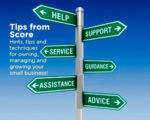Marketing Strategy for Growth
 Question: I have a small business, and I am getting ready to expand. Do I need a formalized marketing strategy to target my growth plan?
Question: I have a small business, and I am getting ready to expand. Do I need a formalized marketing strategy to target my growth plan?
Answer: Philip Kotler, in the middle 1950’s defined marketing as “everything an organization does from the time it perceives the need for a product or service until it is in the hands of the ultimate consumer.”
A business will not succeed because the owner wills it. There must be a market for the product or service. Otherwise, there is no chance of success. To determine your market, you need to consider primary and secondary market research to understand the nature of your market, customer and the competition.
If you were in the pre-launch stage, you need the following information: Is what you are offering something that buyers will want and pay for? How many people want it? Is that sufficient to generate adequate revenue? Who are the potential customers and how do you reach them? How do your potential customers shop? In stores, online, via telephone? Can you create demand for the product or service? How many competitors will you face? How will you compete on price, reliability or quality? Who will our suppliers and partners be and how good are their services?
Since your business is on-going, your marketing efforts should be to identify, satisfy and follow- up on customer needs at a satisfactory profit. This includes market research, marketing strategy, target marketing and managing the marketing mix. It is almost impossible to sell a product or service that people don’t need, and marketing will help you maintain your product line focus to offer products and services that buyers will purchase.
Market Research – you need to systematically gather, record and analyze information regarding your target market and the problems you face in addressing needs. Primary research is “first hand.” A focus group or a survey is primary research. Talking directly to the customer is primary research. Secondary research is gathering and analyzing information generated by others in newspapers, online in blogs, reports or articles, or in magazines. It might be generated by attending Chamber events or conferences where subject matter experts are presenting information about your business segment. Some research is undertaken by just observing. A restaurant owner can observe what is left on customers’ plates and thus modify the menu offerings. A retailer can watch customers as they shop in their store. Where do they go? How are they dressed? Are they alone? What did they buy? And, what didn’t they buy that they looked at?
Marketing Strategy – business planning starts with your objectives and then is further defined by strategies and tactics. Strategies are “what” are you going to do to achieve your objectives and tactics are the “how” you are going to fulfill your strategies. The first element of creating a marketing strategy is to target your market. Most small businesses start out by just selling to anyone who will buy. If your marketing objective for 2016 is to increase awareness of your new product offer that you will use to expand your business, then you will need tactics to execute the strategy. Tactics might include both traditional and digital methods: space advertising Cape Cod Times and Cape and Plymouth Business magazine, launching a Facebook page and becoming more active on LinkedIn. You might also begin blogging and starting a digital newsletter focused on current customers. Growth doesn’t happen by chance.
In the growth stage, you need to think of more targeting and focusing of your sales and marketing initiatives. You can target by geography – Cape and Islands or Cape, Islands and South Shore or Cape, Islands and all of New England. You can target by demographics. By identifying those groups who most likely to buy you can focus your marketing, e.g., high-end boat owners, snowbirds, or sports bikers. A third target category might be product or service attributes. Focus on an attribute that is not offered by others to attract buyers and then move them to a broader offering. Or target your marketing based on psychographics, i.e., lifestyles. This category might be conservationists or health conscious individuals.
A marketing strategy has four ingredients: Product (what are you offering?), Price (how much will you sell your offering for?) Place (where will your offering be available for sale?) and Distribution (how will you get your offering in the hands of the buyer?)











